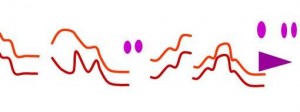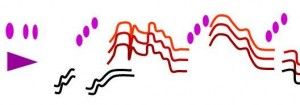Graphic Scores – Aids to Listening
Categories: Composing Activities for Classes
I often find it a delicate task to encourage youngsters to listen to what is considered by some, strenuous or exotic music. I like to lead them though this thorny endeavour with something that is perhaps more familiar to them. One such technique is the use of graphic scores.

 I find that youngsters are often more comfortable with the visual than the aural, so have sometimes prepared a graphic representation of a piece of music to be listened to, using colours, shapes and lines to represent all the music gestures and structure of the piece. I divide this graphic score into fragments which they should reassemble as they listen.
I find that youngsters are often more comfortable with the visual than the aural, so have sometimes prepared a graphic representation of a piece of music to be listened to, using colours, shapes and lines to represent all the music gestures and structure of the piece. I divide this graphic score into fragments which they should reassemble as they listen.
 I may show them the fragments beforehand, and we’ll discuss the sort of music each fragment may represent.
I may show them the fragments beforehand, and we’ll discuss the sort of music each fragment may represent.
I may play them only the very beginning of the music, several times and we’ll work out together which of the fragments represents the music they’re hearing.
Once they’re more familiar with the process and the style of the music, I’ll leave them more and more on their own to work out the remainder for themselves.
Once the fragments are completely assembled in the correct order, this is the time to listen to the music all the way through, following the graphic score.
I may then also show them the actual music score so they can spot similarities between the two sorts of musical mark-making.
Another follow-up activity is to re-interpret the graphic score with their own music ideas, gestures and development, to create their own composition.
And a further follow-up activity is to create a piece of dance which uses as its building blocks, the rhythms and gestures of the music as well as those in the graphic score.
The fragments that are dotted about this writing constitute the entire duration of Copland’s Fanfare For The Common Man. I wonder if you can put them together in the correct order?!
Another similar activity is in my teaching resource Ears Wide Open – Taringa Areare, published by SOUNZ http://sounz.org.nz/resources/show/289 in which James Gardner’s bass clarinet solo “C harge!” is presented as graphic score fragments to be reassembled by the listeners.
harge!” is presented as graphic score fragments to be reassembled by the listeners.

No comments yet.